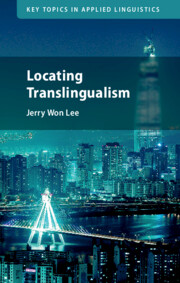Book contents
- Locating Translingualism
- Key Topics In Applied Linguistics
- Locating Translingualism
- Copyright page
- Dedication
- Contents
- Figures
- Acknowledgments
- Notes on the Text
- Introduction
- 1 Translingualism and the Locations of Culture
- 2 Locating Global Korea
- 3 Encountering the Unfamiliar: Languaging Culture
- 4 Visible Nation: Scaling Culture
- 5 Semiotic Excess: Tracing Culture
- Conclusion: More Locations of Culture
- References
- Index
Conclusion: More Locations of Culture
Published online by Cambridge University Press: 31 March 2022
- Locating Translingualism
- Key Topics In Applied Linguistics
- Locating Translingualism
- Copyright page
- Dedication
- Contents
- Figures
- Acknowledgments
- Notes on the Text
- Introduction
- 1 Translingualism and the Locations of Culture
- 2 Locating Global Korea
- 3 Encountering the Unfamiliar: Languaging Culture
- 4 Visible Nation: Scaling Culture
- 5 Semiotic Excess: Tracing Culture
- Conclusion: More Locations of Culture
- References
- Index
Summary
This chapter attempts to inspire readers to pursue complementary inquiry into considerations of global Korea and analogous research into global iterations of other cultural imaginaries. This chapter also attempts to answer the broader question of why the interdisciplinary study of language remains important in today’s global era. On the one hand, contact across cultures and the realities of transculturation are increasingly the norm. However, more importantly, approaching language in this manner enables us to arrive at a more comprehensive understanding of the complex dynamics by which cultures can be rendered distinguishable across global space. It further enables us to attend to the reality that questions of what it means to belong to a given cultural entity to begin with are undergoing radical and unprecedented permutations. Therefore, this chapter suggests that perhaps the question is not so much how today the study of language is more important than ever, but how we can continue to adapt it and be flexible enough so that we can continue to try and make sense of the role of language in relation to the ever-changing contours of cultural belonging today and into the future.
Keywords
- Type
- Chapter
- Information
- Locating Translingualism , pp. 171 - 178Publisher: Cambridge University PressPrint publication year: 2022

